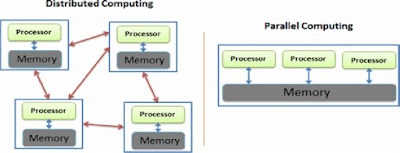Distributed Computing
- Distributed computing makes use of multiple computers or processor machines connected through a network, which can be homogeneous or heterogeneous, but run as a single system.
- The systems connected in a distributed computing environment may be located in the same building or in a place that is geographically dispersed.
- The goal of distributed computing is to make computers of ranging from PC to workstations to minicomputers work together as a single system.
- The advantage of distributed computing over centralized systems are Scalability and Availability.
Cluster Computing:
- Cluster Computing uses parallel architecture, especially Shared Disk Architecture for forming the Cluster that can be shared by multiple computers or processors (CPU) simultaneously.
- It makes use of a set of same or similar type of processor machines connected using a dedicated network infrastructure.
- The individual Computer in a cluster can be referred to as nodes. Each and every node in a cluster shares a common storage and runs software such as Message Passing Interface (MPI) that allows programs to run across all nodes simultaneously.
- The advantage of using Cluster Computing is to allow each and every node to work together with other nodes to solve a complex problem that can't be easily solved by any PC with serial processing.
- All the nodes in a cluster work cooperatively using the software that implements MPI (Message Passing Interface) to solve the problem in hand.
Grid Computing:
- Grid computing uses Shared nothing Architecture of Parallel Computing for connecting multiple computers or processing machines that run parallelly.
- It is a kind of distributed computing in which underutilized computing resources of various organization can be made available to its users through some software that acts as the middleware between those resources available remotely.
- The idea of grid computing is to make use of nonutilized computing power by the needy organization, and thereby Return on Investment (ROP) of those computing resources can be increased.
- The managing functions of resources available in a grid are known as grid services. Grid services provide following functionalities to grid users for effectively managing the resources available on the grid:
- Access control
- Security services
- Data access which include accessing databases and digital libraries
- Access to large-scale and long-term Storage facilities.
- Grid computing is thus named because it looks similar to the electric Power Grid, in which the user doesn't need to know where the electricity comes from (source).
- There is a grid called power grid which acts as a mediator between the source of electricity and the end user. The power grid is made up of transmission stations, power stations, transformers, power lines etc.
- Moreover, Power Grid allows its users to avail power (electricity) as a utility. We ask for electricity and we get it; we also pay for what we get and utilize.
- Similarly, in Grid Computing, Grid provides the Infrastructure and necessary mechanism for accessing computing resources which are available in the form of PC, workstation and servers along with storage elements.
- In grid computing, we ask for computing power or storage capacity and we get it.
Cloud Computing:
- Cloud Computing is a internet-based paradigm, in which shared resources available to end-users on an on-demand basis
- Cloud computing is a kind of Distributed Computing, in which computing power is made available to end users as a utility with a help of various concepts of distributed computing that include virtualization, utility computing, Service Oriented Architecture (SOA) etc.
- The difference between grid Computing and cloud computing is that grid computing supports leveraging several computing and storage devices in parallel to solving a particular problem, while cloud computing supports leveraging multiple resources which are available in one or more data centres to deliver a unified service to the end user.
- The resources available in large data centres are provided in the form of services to either an individual or general public



